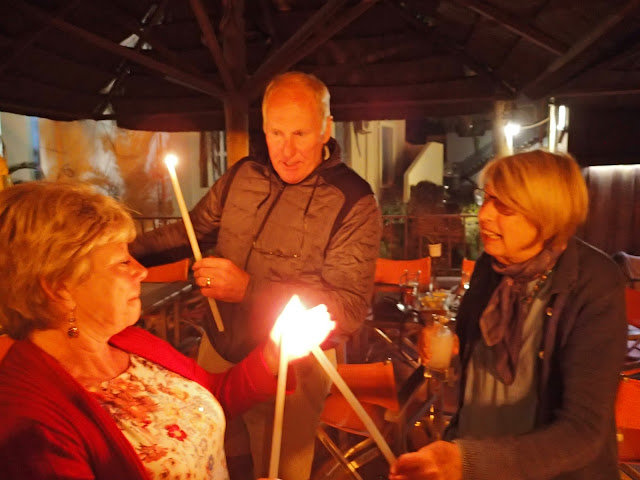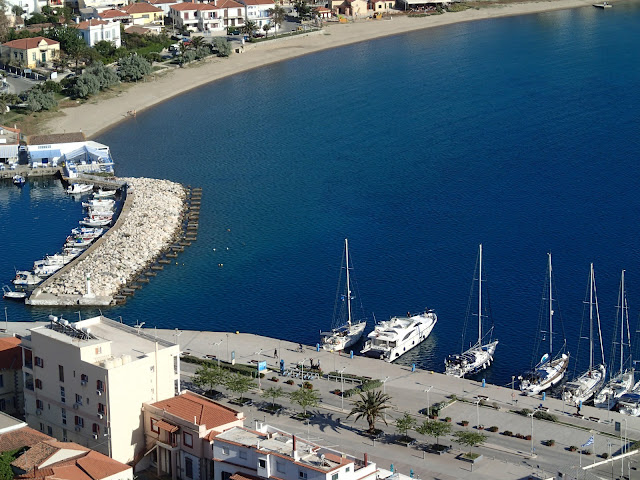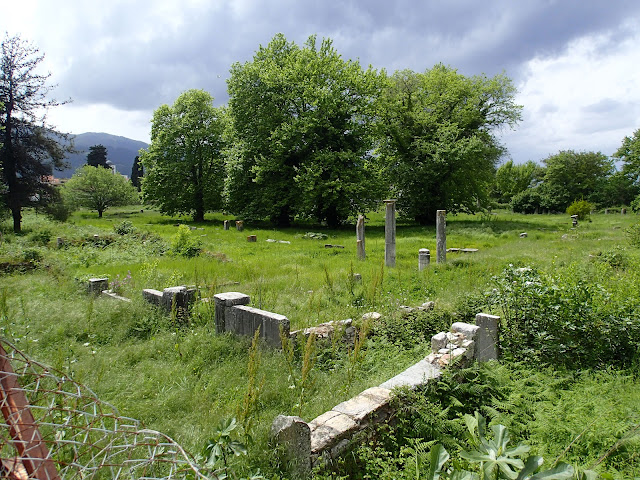We flew to Athens on Sunday 14 April and stayed a couple of
nights with Lena. It was freezing in Athens, while England enjoyed its Easter
heatwave. On Monday we went to lunch with Nikos and Fani and on Tuesday took
the ferry to Leros, arriving just after midnight.
When we got to the boat we found that the boarding ladder
had been lifted and jammed under the solar panels, so we could not get aboard.
Simon went to find a bit of wood to try to haul it down, but that did not work,
so eventually Lin quietly went aboard the next-door boat and then across to
ours and managed to get the ladder down with a couple of judicious kicks. So we
did not have to spend our first night sleeping out in the cold!
The boat was in good condition – dry and not too much dust -
but there was still plenty of cleaning, polishing and maintenance to get on
with, and it was still cold. We spent two weeks pottering around in Lakki,
getting the boat sorted, seeing friends, reading and going to our favourite tavernas.
We had planned to go for some walks, but somehow there was never time.
For Lin’s birthday we had Ray and Carol, Patrick and
Margaret and Frank and Lin for drinks,
then we all went up to Dmitri’s for a birthday dinner,
with a little birthday cake!
We spent Good Friday evening in Poppy’s, waiting for the
Easter parade to go by, watching the fireworks and listening to the
firecrackers, some of which were much too loud for Lin.
As the parade
approached,
Nikos gave us all candle
At the end of the parade came a refugee
family with four little boys, so we gave them our candles, with which they were
delighted.
We decided not to go for the celebration at midnight on
Saturday night – the burning of the effigy of Judas and lots of explosions. We
were very tired so went to bed and slept through all the noise.
We went up to Arkhangelos
for lunch on Easter Sunday with Al and Kitty, their friends Kate and Sarah and Kitty’s father and stepmother.
Most
of them swam, but the sea was only 18 degrees and we chickened out. Rowing back to the boat was enough for us!
We had not decided whether to go north or south for this
year’s long trip. Last year we had gone north, but had to turn back from
Samothraki because the engine would not reverse, missing out on Thassos and
Halkidiki. Since the forecast was for a week of south winds, we decided to head
north again.
On Monday morning, April 29th, we set off north
from Arkhangelos, aiming for the new marina at Agios Kirikos, the island
capital on the southeast coast of Ikaria. We had a comfortable motor sail in a
Force 3-4 southerly wind, arriving at 1 pm after 35 miles. We thought the new
marina was wonderful – very well built quays, at just the right height for
comfort, with rubber strips along the top to fend the boats off.
After lunch we
went for a walk, onto the ferry quay, with a view of the town and the mountains behind,
and the monument to Ikarus,
then along the coast, towards Thermia, a derelict spa, though we did
not get there, and we cooked aboard in the evening.
All the forecasts for Tuesday were for a Force 4 southerly
wind. We set off from Agios Kirikos for Psara, to the northeast of Khios,
in a Force 4 westerly, to find the fan
belt slipping, so we sailed under bare poles while Simon tightened the fanbelt.
When we got to the East end of Ikaria the wind went round to the south, but now
Force 6. A few miles off Ikaria the wind died and then went round to the north,
so we dropped the mainsail and decided to head for Khios marina, instead of
Psara. After a while the wind went round west and we had a confused sea, the
main component being waves from the west of about 2 metres, so we rolled all
over the place. Eventually, as we passed the southern tip of Khios, the wind
went south again, but at Force 5-6, rather than the 4 expected. We shot up the
coast and went in to the derelict, uncompleted Khios marina, but we found that
the wind was blowing straight in through the entrance, making it very
uncomfortable, so we decided to head on for Kardamila, on the north-east corner
of Khios. Although the pilot said that it had strong gusts in a southerly, we
hoped that it would be more sheltered than the channel, though we still faced a
Force 6 southerly wind going in. We had covered 70 miles in ten hours,
including the time spent fixing the fan belt and getting sails up and down.
We saw that Cynusure, from Lakki, was alongside the end of
the quay, but we decided to anchor in the southeast corner of the bay, as
recommended by the pilot, which was lucky, because later a trawler tied up on
the bit of the quay we had thought of going on to. The wind dropped in the
evening and, in the end, we had a peaceful night at anchor in a lovely bay.
We found that we had sprung a batten in the main on the way
up, because the piece holding the batten had split. Simon glued it in the
evening and reinserted the batten next morning, which, fortunately, held.
Repairs completed, we set off at 08.00 on Wednesday, 1st May, for
Sigri, on the South West corner of Lesbos. We had an uneventful 57 mile motor-sail in a
southerly Force 4 wind, dropping later to a 2, (apart from a close encounter with a cargo vessel)
and arrived at Sigri at 14.30,
where we anchored in the south bay, off the castle.
A British boat, who had crossed from the
Sporades, came in a bit later. The wind and swell got up a bit and when they
decided to move to the north bay, we decided to follow them.
The next morning, Thursday May 2nd, we set off
for Myrina on Limnos at dawn, 6am.
The wind started a southerly Force 3, which
gave us a nice beam reach, but later moved round to the north, which made it even colder than on previous days.
We got to Myrina
at 14.30 and tied up on the quay, alongside a very nice Bulgarian family on a
skippered charter.
We had decided to take a break in Myrina, a town that we
love. In the afternoon we did some shopping, took the washing in and had
showers. In the evening we had an excellent and very cheap dinner in a fairly new
taverna in town, Grammofono. Lin had a superb prawn saganaki for 7 euros. On
Friday morning, we went to the archaeological museum, which was now open (last
year it was closed for renovation). The display was superb, with excellent
explanations of everything on display. In the afternoon, we had a good lunch at
the fish taverna on the fisherman’s harbour,
the view down to Mia Hara in the harbour
and the coast to the north
and the south
and to look for the deer, which we could not find.
We left Myrina for Thasos at 6.15 on Saturday, 4th
May. It was a downwind sail in a South-South East Force 4 wind, forecast to
swing round. We did not want to risk a crash gybe, so we motor-sailed with the
genoa. We had an inhabited island to tick off, Koinira on the east coast of Thasos, with a supposed population of five. There was a house on the island, but no sign of life and we could not see a landing place,
so we sailed round it and on, reaching Thasos after 58 miles at 15.00, where we went alongside in the
new harbour.
The harbour was almost empty when we arrived, but late in the
afternoon about 20 charter boats came in, mostly with Bulgarian crews, apparently
taking part in a regatta, pretty well filling the harbour.
We had reached the northernmost point of our adventure,
having covered 275 nautical miles in a week. Although we saw a few yachts in
anchorages, we didn’t see another yacht on passage all the way. Time for a
rest!
Sunday was very windy, with occasional showers. We explored
the ancient ruins in Thassos. In the morning we went to the archaeological
museum, which looked new and built at enormous expense. It was as good as the
Myrina museum, but on a much larger scale, so it was an overwhelming
experience, trying to take it all in. Lin was very taken by the fifth century BC bath.
We went back to the boat for lunch and in
the afternoon explored the ruins. We walked through the agora, which was
beautiful with the luscious grass, wild flowers and trees amid the ruins.
After
the agora we went the wrong way, up a track through beautiful woods and meadows
with wild flowers and bird song. We retraced our steps and passed a temple of Dionysus
and then up the hill to the theatre, meeting a lost chicken on the way.
The theatre was still closed for restoration
(the sign at the bottom said it was 200 metres, but those were Greek metres –
it was at least half a mile up a steep hill). We then went further up to the
top of the hill to the ruins of a medieval castle
built on the base of the ancient acropolis,
and a temple of Apollo,
with fantastic views down to the town and the harbour.
On the way down we took a path which skirted the theatre,
so we at least saw it, though it is more memorable for the location than for
the remains.
In the evening we went to a taverna by the old harbor, Simi,
which had heaters on, and we had a very good dinner. A Bulgarian couple behind
us spent their entire meal playing computer games on their phones, not speaking
to each other at all and barely touching their food!
On Monday, 6th May, we hired a car for the day to
explore the island. The main road goes all the way round the outside of the
island, with roads off going up to the various mountain villages. Until the
nineteenth century most people lived in those villages, to avoid pirates and
raiders, only moving down to the coast in modern times, so while the coast is
lined with modern towns, now mostly tourist resorts, the mountain villages
retain their traditional form, though they too have been much affected by tourism,
catering for tourists and with many houses taken over by expats or for rent as
summer homes.
Our first stop was the Monday market at Prinos. This was not
very exciting – poor people supplying poor people with cheap fruit and veg and
cheap clothes. We just bought a little basil plant and some salad.
We then
drove up into the hills to Mikros and Megalos Prinos (Kazaviti),
with
Macedonian style stone houses with timber balconies,
most of which had been
restored, probably as holiday homes because we didn’t see any people. The road
up through the forest was lined with wild flowers, especially poppies.
We drove on down the rather boring east coast, dropped in to
Limenaria to check out the new harbor, then back up into the hills to the
village of Kastro, where we had lunch at Kostas’ taverna, which was the former school.
Kostas told us that
nobody lives permanently in the village. The young people moved down to
Limenaria and as the older generation died off, the younger ones restored their
houses to use in the summer or to rent to visitors. Kostas himself drove up
every morning and back in the evening.
Some of the houses were derelict or destroyed,
but most had
obviously been restored.
Kostas gave us the key to the little church and directed us
to the bone house,
where the bones of the dead are put in boxes
(and eventually tossed in a heap on the floor) after exhumation.
(and eventually tossed in a heap on the floor) after exhumation.
He then showed us around the 14th
century big church,
which was very lavishly decorated and well maintained (no
photos in the church), with an enclosed balcony for the women. Embedded in the
outer wall was a stone with an inscription from the medieval castle, though it
had been put upside down.
After Kastro we drove back down to the coast and then up to
Theologos, which had been the principal town from the middle ages until the
nineteenth century. This was quite a big town, strung along two streets, with
some large houses, but rather disappointing after Kastro.
We drove back down to the coast again, along the south coast to Alyki, which is a pair of small, well-sheltered coves that has been inhabited continuously since the seventh century BC. The archaeological site is beautifully laid out, with lush green grass and wild flowers along the paths between the remains,
which include a temple of Apollo,
beside which was a knarled olive tree,
a sacred cave, a large early Christian basilica,
and ancient and medieval marble quarries. In the ancient quarry was an unfinished column base.
From Alyki we drove up the much more attractive East coast
along a windy hilly road through forests, looking down to coves and beaches.
Our last stop was at Panagia, a traditional mountain village with a stream
running through it,
where we had coffee and cakes. We stopped off at a supermarket and returned the car at about 7 before having scrambled egg on toast for supper.
where we had coffee and cakes. We stopped off at a supermarket and returned the car at about 7 before having scrambled egg on toast for supper.
On Tuesday May 7th we motored down to Limenaria
(no wind) through a thunderstorm, with heavy bursts of rain and lightning on
the mainland behind us and on the hills of Thassos. It was cold! There were surprisingly large seas, which had us rolling around uncomfortably. We were accompanied for a couple of miles by a young dolphin, who appeared to be herding us away from the shallows. It was eventually joined by another young dolphin and an adult, who disappeared. At Limenaria we went alongside in the new harbour, ready to sail over to Halkidiki the next day. Apart
from a couple of small laid-up yachts, we were the only yacht in the big new harbor.

























































No comments:
Post a Comment
Note: only a member of this blog may post a comment.